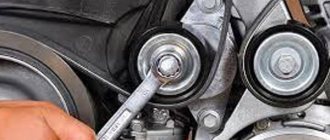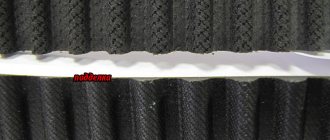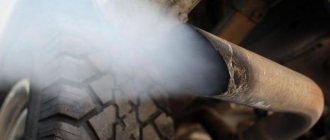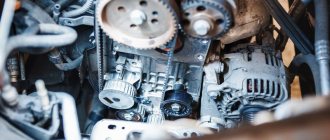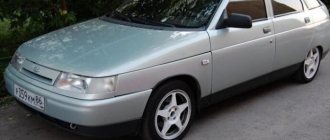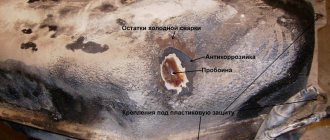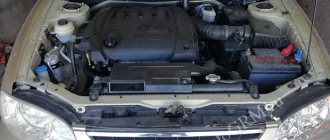Good afternoon. I recently replaced the entire timing group (belt, rollers, tensioner and pump) at a service center; the spare parts are original, according to the service technicians. After the replacement, some kind of howling appeared when the engine was running, clearly audible at about 2000 rpm. The higher the revs, the higher the sound. The power steering and generator belts were removed - the howling remained. I drove about 1500 - the howling did not go away.
I took the car back for service. They spent two days digging around, changing one video, but it didn’t help. They said the belt is 1 micron wider :-), perhaps it is touching something on the gear (crankshaft, it seems), because some washer on it has worn out and sagged, or there may be a little wear on the gear teeth (car 2003 200 thousand did not even pass), but the belt is new. And they also say that the same car came, honked, it had the same sound and this seemed normal (I had no sound before the replacement)... In general, they put it back together, they said nothing bad would happen, then someday everything will pass.
Please tell me: what could be causing this sound, is it normal, what should I do about it. I paid normal money for the repairs and I really don’t want to spend 20 thousand in this regard again to change something for a lot of money or even end up with major repairs. And listening to this sound is not particularly pleasant. Thank you in advance.
The problem associated with strange sounds after replacing the timing belt is familiar to many car owners. The noise after replacing the timing belt appears rhythmic, strange and shuffling, as if something is rubbing against something. Let's try to find out what causes the noise, what are the reasons and what needs to be done.
GRS mechanism: operating principle
ATTENTION! A completely simple way to reduce fuel consumption has been found! Don't believe me? An auto mechanic with 15 years of experience also didn’t believe it until he tried it. And now he saves 35,000 rubles a year on gasoline! Read more"
Let's start with the basics. The GDS system stands out for its extremely complex structure. In order for it to periodically function in the correct mode, it is necessary to timely check and replace certain parts.
To understand why the noise appeared, we need to delve into the structure of the system in more detail.
So, the GDS mechanism is a device that ensures the admission of the fuel mixture into the cylinders of the power plant, and is also responsible for the subsequent elimination of gases.
Considered to be an extremely complex internal combustion engine device, the GDS mechanism is responsible for the proper functioning of the engine valves. Moreover, everything must be carried out strictly within certain periods of time. The functioning of the system must be combined with the operation of other mechanisms.
You can understand how the system works this way. For example, while driving, the driver presses the accelerator pedal to increase the speed of the car. As a result of this, the fuel mixture begins to flow into the internal combustion engine in larger quantities.
A motor is an even more complex device consisting of valves, actuators, shafts, etc. The task of the valves is to open and close in due time, and the drives are to create conditions for the automatic rotation of the shafts along the intended path and with a specific amplitude.
The camshaft pulley is located directly above the BC of the power plant. Valves and special pusher devices are also located here. Outside the cylinder head you can find the cam pulley disc.
Note. To prevent engine lubricant from being knocked out of the cover, the engineers provided a special oil seal.
It is important to understand that the new belt, which suddenly began to make noise, is put on the camshaft disc and receives its movement when the crankshaft flywheel rotates.
For good, or rather, correct belt tension, rollers are used. We must always monitor their normal functioning, just like the belt, they must be changed in a timely manner.
Consequences for the car
If you ignore the whistle and continue to drive with a worn timing belt or a skewed tensioner, you may encounter a drive failure. This will create a desynchronization in the movement of the piston system and the cylinder head valve mechanism. They will begin to converge and disperse chaotically. The internal combustion engine will definitely stall and it will be impossible to start it. You will have to tow the car to the service station, calling a friend on wheels or a taxi.
Bend valves
But that is not all. In some engine models, this means that the pistons and valves will literally meet. Since the connecting rods are more powerful, the valve stems bend during a collision. The nickels themselves may break off and parts of them will fall into the cylinders. For repairs, you will need to completely remove the cylinder head, oil pan, crankshaft, connecting rods and check each cylinder for metal debris. Then buy new valves and restore the broken seats in the block head. To do this, they are welded with argon, then sharpened and ground. Therefore, you should not ignore the whistle and it is better to immediately contact the service.
Potential Noise Contributors
So, many car owners who complain about timing belt noise have noted that the belt whistles more often when the engine is cold. In other words, when starting the engine.
Fortunately or unfortunately, this kind of problem is very common. Below are the most common causes of belt noise.
- Wear of gas distribution system components. It is not surprising that those elements that work in tandem with the timing belt, after wearing out, no longer cope with their tasks as before. For example, if the teeth of the shaft wheels are worn out.
- The belt itself has worn out, or rather, its teeth. In this case, it is already customary to talk not about the whistling of the belt after replacement, but about the noise of a worn-out product. Definitely, replacing the belt with a new element will help solve this problem if there are no other faults.
- Weak tension. If the HTZ roller is faulty or the tension is weak, the timing belt may whistle.
- The belt may also make noise if it gets grease or other compounds on it. For example, if a noise appears when the power plant is starting up when it is cold, this usually indicates a leak of coolant or lubrication of the internal combustion engine.
Brake fluid may also get on the belt for some reason. Also, aggressive liquid can get into the mechanism of any shaft disk.
- A whistle that appears immediately after replacement may also indicate poor quality of the product. Most likely, this belt was purchased for little money. Only replacing the belt with a better version will help, and nothing more.
Note. In some cases, the belt is lubricated, and then it no longer whistles, but only for a certain time. Then the “pandemonium” noisily begins again.
- Belt noise is also possible due to wear on the roller. If it has already served its service life and has not been replaced along with the belt, the whistle is its consequences. To eliminate the noise, you will have to replace the roller.
Understanding the device
To understand why the timing belt whistles after replacing it or after a long period of use, when starting the engine or simply when it is running, you need to understand the device. The issue of noise is pressing for many domestic motorists.
Removing the timing belt
The timing belt is a device that ensures the admission of the combustible mixture into the engine cylinders and the further removal of exhaust gases from the combustion chamber. This mechanism, as mentioned above, is one of the most complex motor devices, since it must not only open and close the valves. The timing belt must be done in a specially designated period of time. In any case, the operation of the unit must be synchronized with the functioning of the ignition and injection system.
When the driver needs to increase the speed, he presses the gas pedal, thus ensuring that more gasoline and fuel mixture enters the engine. This device consists of several groups of parts. Engine valves are designed to open and close intake and exhaust ports. The engine drives ensure rotation of the shafts at a specific speed. And the purpose of the distribution pulleys is to control the valves.
A head is installed above the cylinder block of the internal combustion engine, on which you can see the distribution pulley, valves and pusher devices. The timing pulley disk is located outside the cylinder head. To prevent engine fluid from leaking out from under the valve cover, a special oil seal is installed on the camshaft. The timing belt, which suddenly whistles after replacement, is put on the camshaft pulley disk and begins to function when the crank pulley gears rotate.
To ensure that the timing belt is always well tensioned, tension rollers are used. The strap itself ensures the operation of the device, and the drive strap ensures the operation of additional equipment. This is what the gas distribution mechanism system looks like in brief. But why did the noise appear when the engine was cold when starting? And why does the timing belt whistle after replacement? How can this noise be related to the operation of the engine?
Methods for eliminating noise
The noise that appears immediately after starting the engine can be eliminated in several ways. All of them will be discussed in detail below.
Lubrication
As mentioned above, lubrication of the element, although not for long, eliminates the whistling and noise of the strap. This is the most popular solution to the problem if a whistle appears after installing a new belt.
The lubricant in this case is a special type of aerosol, sold in every store. In addition, the universal VD-40 is also suitable for these purposes.
Step-by-step instructions for lubrication:
- You need to open the hood of the car.
- Remove the protective cover secured with bolts.
- Start the engine.
Note. Lubricating the elements of the hydraulic lubrication mechanism on a running engine is much more effective than on a stationary internal combustion engine. Yes, this will require some skill, which boils down to the fact that you need to be able to aim accurately and get the liquid onto the inner parts of the strap.
- You need to lubricate for 5-10 seconds, so that this time is enough to process all the belt teeth.
- Then you need to turn off the engine, put the cover back in place and check for noise.
Leak and its elimination
The first reason for an oil leak lies in the cylinder head gasket. If it breaks through, it provokes timing belt noise. Surely, if oil or liquid gets on the belt, noise starts.
Here's what to do:
- Check the cylinder head for leaks.
- If the top deviates from the BC even by a small distance, you should remove the head and grind it.
- Be sure to replace the gasket, since in most cases it is the reason for lubricant leakage.
AvtoVAZ recommendations for eliminating noise and grinding noise in the timing drive area
During operation of Lada Granta, Kalina and Priora cars equipped with 8-valve engines, the discrepancy “Noise, grinding noise during engine operation, in the timing drive area” may appear. The cause of the noise is the contact of the camshaft pulley with the rear protective cover of the timing belt 21116-1006209-01 due to deformation of the cover. This is described in information letter No. 12-19 dated 02/06/2019.
If the owner contacts the LADA dealership with this problem, the auto center specialists will eliminate extraneous noise in accordance with the factory recommendations. Additionally, when dismantling the rear protective cover, the condition of the site for installing an automatic timing belt tensioner on the cylinder head will be monitored.
Recommendations for eliminating extraneous noise in the area of the camshaft drive pulley of 8-valve engines
1.
Localize the source of the noise, make sure that there is no contact between the vertical surface of the rear toothed belt protective cover and the cylinder head (zone “B” in the figure).
2.
Measure the gap between the camshaft pulley and the rear toothed belt protective cover in the contact area.
3.
Remove the rear toothed belt protective cover and related drive parts. Check the completeness of the rear toothed belt protective cover. Confirm the presence of harmful contact of the camshaft pulley with the rear toothed belt protective cover.
4.
Check the flatness of the rear toothed belt guard on the surface plate. According to the drawing, the flatness parameter is 1 mm.
5.
Inspect the condition of the site for mounting the automatic toothed belt tensioner on the cylinder head, checking for the presence of rough sprues and burrs in zone “A”:
An example of a casting (gate) defect in zone “A”:
6.
If there are significant casting defects of a metallurgical nature, burrs (more than 3 mm), rough sprues in zone “A”, it is necessary to take measurements of 4 overall dimensions of the site.
7.
After receiving approval in the message/request, use a bench tool (file) to bring the cylinder head platform in zone “A” into compliance with the dimensions indicated above.
Attention! Do not modify the cylinder head in zone “B”. The condition of the cylinder head is in zone “B”, the presence of discontinuities does not provoke noise in the area of the camshaft drive pulley, because
does not affect the distance between the camshaft pulley and the protective rear timing belt cover.
8.
Install a new rear toothed belt protective cover. In this case, it is necessary to control the flatness similar to the recommendations in paragraph 4.
Source
Potential Noise Contributors
So, many car owners who complain about timing belt noise have noted that the belt whistles more often when the engine is cold. In other words, when starting the engine.
How to check noise
Fortunately or unfortunately, this kind of problem is very common. Below are the most common causes of belt noise.
- Wear of gas distribution system components. It is not surprising that those elements that work in tandem with the timing belt, after wearing out, no longer cope with their tasks as before. For example, if the teeth of the shaft wheels are worn out.
- The belt itself has worn out, or rather, its teeth. In this case, it is already customary to talk not about the whistling of the belt after replacement, but about the noise of a worn-out product. Definitely, replacing the belt with a new element will help solve this problem if there are no other faults.
- Weak tension. If the HTZ roller is faulty or the tension is weak, the timing belt may whistle.
- The belt may also make noise if it gets grease or other compounds on it. For example, if a noise appears when the power plant is starting up when it is cold, this usually indicates a leak of coolant or lubrication of the internal combustion engine.
Brake fluid may also get on the belt for some reason. Also, aggressive liquid can get into the mechanism of any shaft disk.
- A whistle that appears immediately after replacement may also indicate poor quality of the product. Most likely, this belt was purchased for little money. Only replacing the belt with a better version will help, and nothing more.
Note. In some cases, the belt is lubricated, and then it no longer whistles, but only for a certain time. Then the “pandemonium” noisily begins again.
- Belt noise is also possible due to wear on the roller. If it has already served its service life and has not been replaced along with the belt, the whistle is its consequences. To eliminate the noise, you will have to replace the roller.
How to get rid of whistling
If you hear a whistle, you should figure out what exactly is making the sound in the car. This could be a timing belt, an alternator belt, or rollers.
The most common cause of whistling is insufficient tension.
Tension check
First of all, check the belt tension.
Rule out that the alternator belt is whistling. Press on it, it should bend with a force of 10 kg by 10–15 millimeters.
After this, check the timing belt. It should rotate up to 90 degrees with a force of 1-2 kg. There are also special tensioners on sale, with the help of which the standard value is set.
Methods for eliminating noise
The noise that appears immediately after starting the engine can be eliminated in several ways. All of them will be discussed in detail below.
Lubrication
As mentioned above, lubrication of the element, although not for long, eliminates the whistling and noise of the strap. This is the most popular solution to the problem if a whistle appears after installing a new belt.
Universal VD-40
The lubricant in this case is a special type of aerosol, sold in every store. In addition, the universal VD-40 is also suitable for these purposes.
Step-by-step instructions for lubrication:
- You need to open the hood of the car.
- Remove the protective cover secured with bolts.
- Start the engine.
Note. Lubricating the elements of the hydraulic lubrication mechanism on a running engine is much more effective than on a stationary internal combustion engine. Yes, this will require some skill, which boils down to the fact that you need to be able to aim accurately and get the liquid onto the inner parts of the strap.
- You need to lubricate for 5-10 seconds, so that this time is enough to process all the belt teeth.
- Then you need to turn off the engine, put the cover back in place and check for noise.
Leak and its elimination
The first reason for an oil leak lies in the cylinder head gasket. If it breaks through, it provokes timing belt noise. Surely, if oil or liquid gets on the belt, noise starts.
Here's what to do:
- Check the cylinder head for leaks.
- If the top deviates from the BC even by a small distance, you should remove the head and grind it.
- Be sure to replace the gasket, since in most cases it is the reason for lubricant leakage.
If there is an antifreeze leak:
- Diagnose the area where the cylinder head comes into contact with the block. Most likely, coolant penetrates into the internal combustion engine due to a broken cuff. It is also recommended to check all attachments, including hoses and fittings. They should not be worn out, and nothing should leak from anywhere.
If other fluids are leaking:
- If a coolant or car air conditioning fluid leaks, first of all, possible leak locations are diagnosed. With a functioning internal combustion engine, it will be useful to diagnose the GDS mechanism, and if it does not help identify the cause, disassemble the mechanism and remove the belt.
Belt wear
The GDS belt of the mechanism ensures synchronous rotation of the shafts, ensuring timely opening/closing of the valves. A worn belt will eventually break, but it can function in semi-working condition for some time. This can also explain the whistle or other noise coming from the GDS mechanism.
Timing belt wear
Below are common signs that your belt is wearing out.
- If the belt looks “shaggy” in appearance.
- Micro- or macrocracks are visible on the belt.
The main traces of “aging” of the timing belt can be seen on the reverse side of the product. This very jagged inner part bears traces of dirt or the result of poor road conditions.
In order to somehow increase preventive measures for caring for the belt, you should periodically monitor the condition of the protective casing. It is from here that, if the lid is not closed well, most of the dirt and dust gets in. It is important to understand that the integrity of the protective casing is the reliability of the belt and its long service life.
There are also indirect signs of belt wear. For example, one of these signs involves wear on the drive belt. In this case, knowing about the similarity of both resources and their approximately equal wear, the owner diagnoses the drive belt. If the latter looks clearly worn out, then almost 90 percent of the time one can also judge that the timing belt is worn out.
Roller wear
When noise appears from the timing belts, it is imperative to identify the cause. But various components and installations can make noise, there are many of them, how can we determine for sure that it is NTZ?
An endoscope is an excellent and very useful tool for checking the characteristic noise of various properties. Sound mesomerism, in most cases, is diagnosed with a screwdriver or a metal rod, but you can do without it using modern endoscopes.
Timing tension roller
If you cannot find the cause of the noise through an endoscope, you will have to remove the belts and start the internal combustion engine without them. When the characteristic noise disappears, doubt instantly falls on the rollers. We will need to take the endoscope again and diagnose the noise.
A specialist will immediately identify the characteristic noise coming from failed roller bearings. In this case, the sound comes out clearly, the noise is heard very well.
It is advisable to change all the rollers at the same time, so as not to do the same job twice. In other words, if 1 bearing makes noise, then soon expect the remaining roller bearings to fail.
All bearings last a commensurate amount of time, since they have a similar design and, as a rule, experience the same load.
In some cases, professionals recommend paying attention to the rubber damper of the crankshaft wheel. When it wears out, the crankshaft pulley begins to rub against the protective cover, which causes intense noise that is transmitted to all attachments.
It is important to check the damper not only for appearance, but also for the correct clearance.
Other reasons
Of course, there are many minor problems that were not described here and that lead to noise when turning the steering wheel of the Lada Granta. When knocking and squeaking noises appear when turning the steering wheel, the Granta should be examined by specialists if you are not confident in your experience in diagnosing the car. Otherwise, you risk breaking the car.
Comfort when driving a Lada Granta car consists of many factors, one of which is the operation of the front suspension. Knocking, noise, and “breakdowns” of the suspension also affect traffic safety, so timely diagnosis of breakdowns of this unit is simply necessary. It is better to carry it out at a service center, but some faults can be identified yourself.
Why does the timing belt make noise when cold?
Many car owners are faced with such a problem as a sharp whistle (squealing) from under the hood when the engine is running. It can appear both when the engine is “cold” and when the engine is fully warmed up, under different loads. Usually everyone starts to blame the occurrence of such a problem on the generator and its belt. At the same time, they do not pay attention to the second belt drive - the gas distribution mechanism.
But the appearance of a whistle in it is a more dangerous problem than in the drive belt of attachments. In general, it is not difficult to find out which drive has problems. It is enough to remove the alternator belt from the car and start the engine. A squeak that disappears or continues to sound will let you know where to look for the cause. If there is a squeal even with the belt removed, there is definitely a problem with the timing drive.
To more accurately identify what exactly caused it without any disassembly, you can use a technical phonendoscope. Using it, you can identify the area where the sound occurs, which will allow you to immediately determine which of the elements is faulty after sampling.
There are not so many main reasons for timing belt whistling:
- The belt itself can make sounds. If it is extremely worn, made of low-quality material, and not tensioned enough, then passing through the rollers (and it contacts them with a smooth surface), it will slip, making unpleasant sounds;
- The rollers may squeal due to the belt being tightened;
- Technical fluids (oil, antifreeze) have come into contact with the drive. As a result, they act as swarms of lubricant, reducing friction between the surfaces of the rollers and the belt, which causes slippage;
- Bearing wear. To ensure ease of rotation of the rollers and pump, bearings are installed in their design. If these elements are extremely worn out or there is insufficient lubrication, then increased friction occurs in them, accompanied by a squealing sound;
- Carelessness in carrying out work to replace the belt, resulting in the bending of the axis of one of the rollers. This leads to the fact that the position of the roller changes slightly, and due to a slight misalignment, the friction between the drive and the tension or bypass element increases
Each of the reasons has its own characteristic features. For example, if you use a belt made of low-quality material that does not have sufficient elasticity, then in winter the rubber will “tan” after being parked in the cold. As a result of this, the drive element will be the cause of the “cold” whistle, which disappears after heating.
AvtoVAZ recommendations for eliminating noise and grinding noise in the timing drive area
During operation of Lada Granta, Kalina and Priora cars equipped with 8-valve engines, the discrepancy “Noise, grinding noise during engine operation, in the timing drive area” may appear. The cause of the noise is the contact of the camshaft pulley with the rear protective cover of the timing belt 21116-1006209-01 due to deformation of the cover. This is described in information letter No. 12-19 dated 02/06/2019.
If the owner contacts the LADA dealership with this problem, the auto center specialists will eliminate extraneous noise in accordance with the factory recommendations. Additionally, when dismantling the rear protective cover, the condition of the site for installing an automatic timing belt tensioner on the cylinder head will be monitored.
Recommendations for eliminating extraneous noise in the area of the camshaft drive pulley of 8-valve engines
1.
Localize the source of the noise, make sure that there is no contact between the vertical surface of the rear toothed belt protective cover and the cylinder head (zone “B” in the figure).
2.
Measure the gap between the camshaft pulley and the rear toothed belt protective cover in the contact area.
3.
Remove the rear toothed belt protective cover and related drive parts. Check the completeness of the rear toothed belt protective cover. Confirm the presence of harmful contact of the camshaft pulley with the rear toothed belt protective cover.
4.
Check the flatness of the rear toothed belt guard on the surface plate. According to the drawing, the flatness parameter is 1 mm.
5.
Inspect the condition of the site for mounting the automatic toothed belt tensioner on the cylinder head, checking for the presence of rough sprues and burrs in zone “A”:
An example of a casting (gate) defect in zone “A”:
6.
If there are significant casting defects of a metallurgical nature, burrs (more than 3 mm), rough sprues in zone “A”, it is necessary to take measurements of 4 overall dimensions of the site.
7.
After receiving approval in the message/request, use a bench tool (file) to bring the cylinder head platform in zone “A” into compliance with the dimensions indicated above.
Attention! Do not modify the cylinder head in zone “B”. The condition of the cylinder head is in zone “B”, the presence of discontinuities does not provoke noise in the area of the camshaft drive pulley, because
does not affect the distance between the camshaft pulley and the protective rear timing belt cover.
8.
Install a new rear toothed belt protective cover. In this case, it is necessary to control the flatness similar to the recommendations in paragraph 4.
Source
Why does the timing belt make noise (whistle) when hot?
Reader question: Good afternoon. Engine A20DTH (160 hp). The problem is this: after the engine warms up, at idle speed, an extraneous rustling noise is heard in the timing belt area. When the speed increases, the noise is not audible. The noise appears only at idle and when the engine is fully warmed up, i.e. if the engine temperature is less than 90 and the speed is idle, then there is no noise. Two weeks ago, the OD had the timing belt and rollers replaced under warranty (cyclical shuffling on a cold engine). When cold it now works like a charm - without any extraneous sounds, but when it's hot it rustles. What is the reason?
The GDS belt of the mechanism ensures synchronous rotation of the shafts, ensuring timely opening/closing of the valves. A worn belt will eventually break, but it can function in semi-working condition for some time. This can also explain the whistle or other noise coming from the GDS mechanism.
Below are common signs that your belt is wearing out.
- If the belt looks “shaggy” in appearance.
- Micro- or macrocracks are visible on the belt.
The main traces of “aging” of the timing belt can be seen on the reverse side of the product. This very jagged inner part bears traces of dirt or the result of poor road conditions.
In order to somehow increase preventive measures for caring for the belt, you should periodically monitor the condition of the protective casing. It is from here that, if the lid is not closed well, most of the dirt and dust gets in. It is important to understand that the integrity of the protective casing is the reliability of the belt and its long service life.
There are also indirect signs of belt wear. For example, one of these signs involves wear on the drive belt. In this case, knowing about the similarity of both resources and their approximately equal wear, the owner diagnoses the drive belt. If the latter looks clearly worn, then almost 90 percent of the belt can also be judged to be worn.
A grinding noise is heard when starting the engine
If the driver turns the ignition key to the “start” position and at this moment a grinding noise is heard, and the noise disappears after the engine “cages” and starts working on its own, then the most common cause is considered to be a faulty starter.
If, when starting the engine, you hear the starter grinding whether it is cold or hot, then there may be several reasons for such a malfunction.
As a rule, it is necessary to check the solenoid relay, starter bendix and flywheel. The fact is that the bendix may not engage with the flywheel properly, resulting in a crackling sound or a characteristic starter grinding sound when starting the engine.
